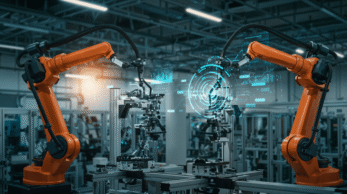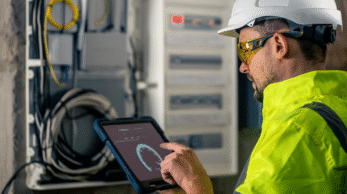Sommaire
Why are digital twins a game-changer for maintenance?
Maintenance managers are constantly seeking ways to prevent equipment failures, maximize
A technology that goes beyond static visualization
Unlike traditional static models, digital twins are dynamic and adaptive. Powered by data from IoT sensors, SCADA systems, and CMMS platforms, they provide a real-time, accurate view of assets.
Take the example of energy turbines: sensors track vibrations and temperature changes, feeding data into the digital twin. This enables early detection of anomalies, offering a critical window to intervene and prevent major failures. By moving beyond passive monitoring, digital twins turn raw data into actionable insights in real time.
Unlocking the Predictive Potential of Digital Twins
What sets digital twins apart is their ability to simulate and predict. Using physical and algorithmic models, they forecast the impact of usage cycles, environmental conditions, and workloads on equipment. These simulations help refine maintenance strategies.
According to Gartner, companies using digital twins have reduced maintenance costs by an average of 10%. Additionally, AI-driven algorithms enhance predictive accuracy by identifying subtle trends that human teams might overlook.
A Holistic Approach to Maintenance
Digital twins enable comprehensive analysis of industrial assets, including the complex interplay between machines. In the automotive sector, for instance, they optimize coordination among multiple robots on assembly lines, minimizing unexpected interruptions. This systemic approach provides maintenance teams with a unified, forward-looking perspective, streamlining strategic decision-making.
The integrated ecosystem: digital twins, predictive maintenance, and CMMS working together
A technological architecture connecting data, models, and systems
At the heart of this integration is a robust technological framework. Digital twins collect real-time data from diverse sources like IoT sensors, SCADA systems, and CMMS platforms. This interconnected architecture facilitates precise and immediate equipment analysis.
CMMS plays a pivotal role in this ecosystem by centralizing data, scheduling interventions, and ensuring complete traceability. This synergy allows maintenance managers to develop tailored strategies aligned with operational goals.
Advanced use cases: optimized and predictive maintenance
Digital twins are reshaping how businesses manage industrial assets. By modeling machine behavior, they can detect early signs of failure. In the aerospace industry, for example, airplane engines equipped with digital twins undergo continuous monitoring. This not only reduces unplanned downtime but also optimizes resource allocation and intervention planning.
Simulations further enhance decision-making by testing scenarios without disrupting operations. Maintenance managers can evaluate the effects of increased production loads or strategy shifts while minimizing risks and costs.
Challenges and methodologies: implementing an augmented maintenance strategy
Data management and interoperability: key technological priorities
The success of digital twins depends on effective data collection and management. However, the diversity of data formats and sources can pose integration challenges. Investing in solutions that ensure optimal interoperability is critical. Adopting open standards like OPC UA enables smooth communication across platforms.
Assessing digital maturity: an essential step
Before deploying digital twins, organizations must assess their digital maturity. This evaluation identifies gaps in infrastructure, skills, and organizational culture. Frameworks like the Digital Maturity Model provide clear roadmaps for prioritizing initiatives.
Key next steps include:
- Team training: Building expertise in data management, modeling, and predictive analysis.
- System modernization: Ensuring compatibility between existing infrastructure and new digital tools.
- Change management: Engaging stakeholders and communicating the anticipated benefits of the project.
A vision for the future: digital twins as cCatalysts for Industry 4.0
Mid- and long-term opportunities for proactive maintenance
Digital twins are driving profound changes in the industry. In the medium term, widespread adoption will enable:
- Further reductions in unexpected downtime through prescriptive maintenance.
- Improved asset longevity via optimal usage recommendations.
- Enhanced resource efficiency through advanced simulations.
The evolution toward prescriptive maintenance, where systems recommend specific actions, promises to revolutionize industrial practices even further.
Emerging roles in maintenance
As innovations reshape the industry, the role of maintenance technicians is evolving. Skills in data management, AI, and modeling are becoming essential. Companies must prepare for this shift by offering training programs and developing new roles, such as digital maintenance analysts and integrated ecosystem managers.
Digital twins represent a strategic breakthrough for maintenance managers, delivering operational efficiency, cost savings, and sustainability. Their integration with CMMS and predictive processes is transforming industrial asset management, paving the way for intelligent, proactive maintenance. Businesses investing in these technologies will position themselves as leaders in Industry 4.0, ready to tackle tomorrow’s challenges with innovation and precision.




